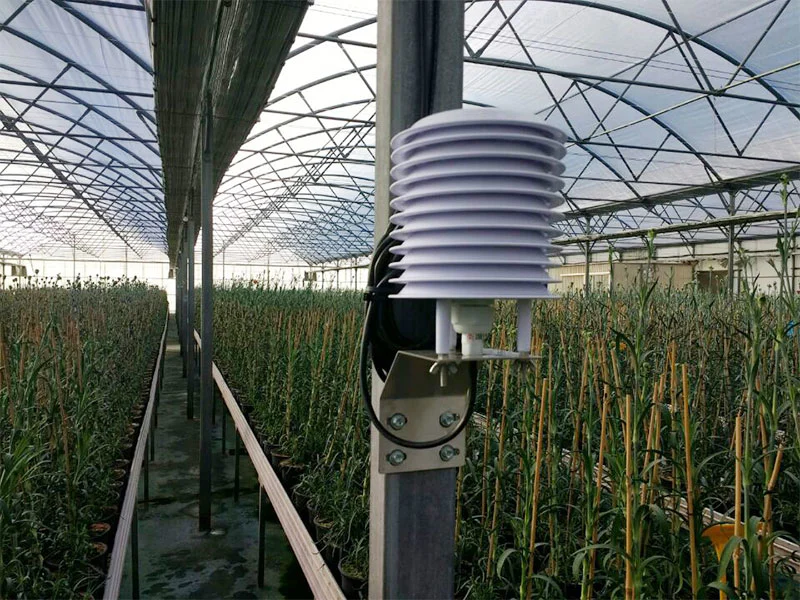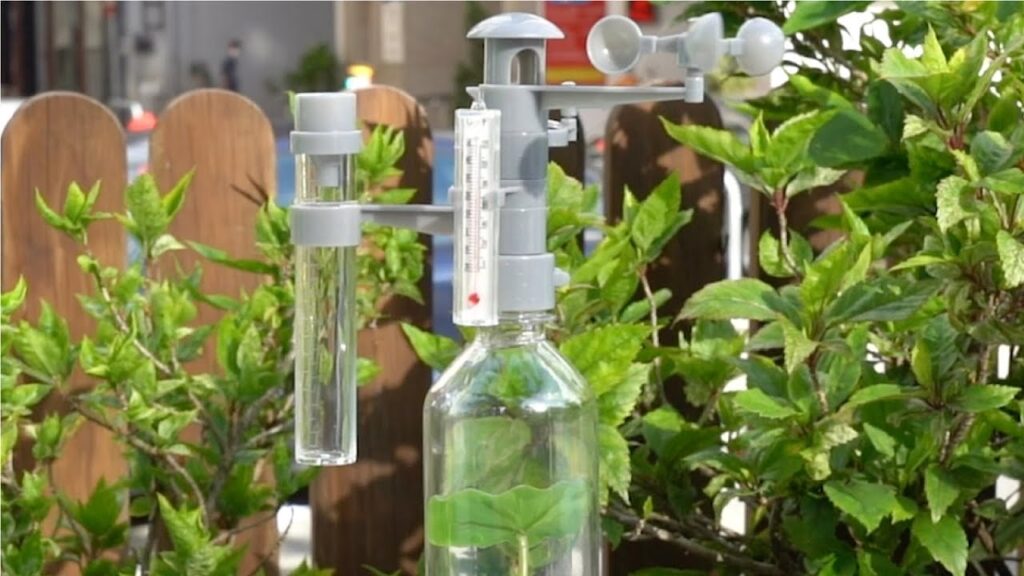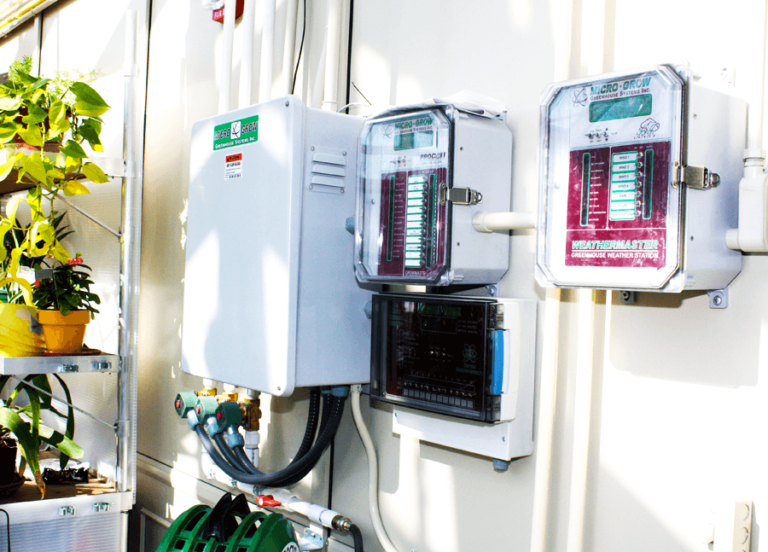A Greenhouse Weather Station is a tool that helps farmers monitor and control the environment in a greenhouse. It typically includes sensors to measure temperature, humidity, light, and soil conditions. Installation involves securing the station at a recommended height, calibrating sensors, and ensuring a stable power supply.
The central monitoring unit is set up to log and transmit data. Optimal sensor placement is crucial, for instance, temperature sensors should be away from direct sunlight.
Troubleshooting involves addressing common issues like data discrepancies or connectivity problems. Regular checks and maintenance ensure the system provides accurate data for effective greenhouse management.
What Are The Benefits of Using a Greenhouse Weather Station?

Increased Crop Yield and Quality
Greenhouse Weather Stations play a pivotal role in enhancing crop yield and quality. By continuously monitoring environmental conditions such as temperature, humidity, and light levels, farmers can create an optimal environment for plant growth.
This precision agriculture approach ensures that crops receive the ideal conditions they need to thrive, leading to increased productivity. The controlled environment also minimizes stress on plants, reducing the likelihood of stunted growth and yield losses.
As a result, farmers can achieve higher and more consistent crop yields, contributing to overall profitability.
Prevention of Diseases and Pests
One of the significant challenges in agriculture is the threat of diseases and pests. Greenhouse Weather Stations act as proactive tools in disease and pest management.
By closely monitoring environmental parameters, farmers can detect conditions conducive to the development of diseases or the proliferation of pests
Early identification allows for timely intervention, whether through adjusting environmental conditions, implementing targeted treatments, or employing integrated pest management strategies.
This preventive approach not only safeguards the crops but also reduces the reliance on chemical treatments, promoting sustainable and eco-friendly farming practices.
Optimal Resource Utilization (Water, Energy, etc.)
Efficient resource management is crucial in modern agriculture, and Greenhouse Weather Stations contribute significantly to optimizing resource utilization. These systems provide real-time data on factors such as soil moisture, enabling farmers to implement precise irrigation strategies.
By tailoring water usage to the specific needs of the crops, unnecessary water consumption is minimized, leading to water conservation and cost savings.
Additionally, by monitoring and controlling environmental parameters, such as temperature and ventilation, energy consumption within the greenhouse can be optimized, making the entire operation more sustainable and economically viable.
Improved Decision-Making for Greenhouse Management
Informed decision-making is at the core of successful greenhouse management, and Greenhouse Weather Stations serve as invaluable decision support tools.
The continuous collection of data on environmental conditions allows farmers to make data-driven decisions regarding planting times, harvesting schedules, and overall crop management strategies.
The historical data provided by these stations enables trend analysis, helping farmers anticipate seasonal variations and make proactive adjustments to optimize crop outcomes.
Furthermore, the integration of data analytics and visualization tools enhances the comprehensibility of the information, empowering farmers to make timely and effective decisions for the long-term success of their greenhouse operations.
What Are The Key Features of a Greenhouse Weather Station?
Real-time Monitoring of Temperature, Humidity, and Light Levels
One of the fundamental features of a Greenhouse Weather Station is its capability for real-time monitoring of crucial environmental variables such as temperature, humidity, and light levels.
This real-time data acquisition is essential for creating and maintaining the optimal growing conditions within the greenhouse. For instance, precise temperature control ensures that plants are not exposed to extreme heat or cold, while monitoring humidity levels helps prevent issues like mold or fungal growth.
Additionally, tracking light levels is critical for adjusting artificial lighting systems to supplement natural sunlight, ensuring plants receive the appropriate amount of light for photosynthesis.
Data Logging and Historical Analysis
The ability to log and analyze historical data sets Greenhouse Weather Stations apart as sophisticated tools for precision agriculture. By recording environmental conditions over time, farmers gain valuable insights into seasonal trends, variations, and long-term patterns.
This historical data analysis aids in decision-making, allowing farmers to optimize planting and harvesting schedules, predict crop behavior under specific conditions, and identify opportunities for efficiency improvements.
Moreover, historical analysis is beneficial for assessing the effectiveness of implemented changes or interventions, contributing to continuous refinement of greenhouse management practices.
Integration with Automation Systems
Greenhouse Weather Stations are designed to seamlessly integrate with automation systems, enhancing the overall efficiency and precision of greenhouse operations. Integration allows for automated control of various environmental parameters based on real-time data.
For example, if the temperature exceeds a certain threshold, the system can automatically adjust ventilation or cooling systems.
Similarly, in response to low light levels, the automation system can trigger supplementary lighting. This integration not only reduces the need for manual intervention but also ensures that environmental conditions are consistently optimized, creating a stable and controlled growth environment for crops.
Remote Access and Control
The feature of remote access and control is a game-changer in modern greenhouse management. Greenhouse operators can monitor and control the weather station from anywhere with an internet connection, providing flexibility and convenience.
Whether through a dedicated application or web interface, remote access allows farmers to check real-time data, receive alerts for critical conditions, and make adjustments to the greenhouse environment remotely.
This capability is particularly valuable for responding promptly to unforeseen changes, optimizing resource usage, and ensuring that the greenhouse operates efficiently even when physical presence is not possible.
How Greenhouse Weather Stations Work
Sensors and Data Collection Methods
Greenhouse weather stations are equipped with a variety of sensors to monitor key environmental parameters. These sensors play a crucial role in providing accurate and real-time data for maintaining optimal conditions within the greenhouse. Common sensors include
- Temperature Sensors: These sensors measure the air and soil temperature. Accurate temperature data is essential for managing the climate inside the greenhouse.
- Humidity Sensors: Monitoring humidity levels helps prevent issues such as mold growth and ensures the right conditions for plant transpiration.
- Light Sensors: These sensors measure the intensity and duration of light. This data is vital for understanding the light requirements of different crops and adjusting artificial lighting accordingly.
- Soil Moisture Sensors: Measuring soil moisture content helps in optimizing irrigation, preventing overwatering or underwatering of plants.
- Wind Speed and Direction Sensors: These sensors provide insights into the airflow within the greenhouse, aiding in the prevention of heat pockets and ensuring even distribution of environmental factors.
Data collection methods involve the continuous monitoring of these parameters. Advanced weather stations utilize automated data collection systems, often employing wireless sensor networks. This enables real-time monitoring and provides a comprehensive dataset for analysis.
Communication Protocols
Efficient communication is crucial for transmitting the collected data from the sensors to the central monitoring system. Common communication protocols include
Wireless Communication
Many modern greenhouse weather stations use wireless protocols like Zigbee or Wi-Fi for transmitting data. Wireless communication allows for flexible sensor placement and reduces the need for extensive wiring.
LoRa (Long Range)
LoRa is a low-power, long-range wireless communication technology that is well-suited for remote or large agricultural areas, providing extended coverage for greenhouse complexes.
Cellular Networks
Some weather stations utilize cellular networks for data transmission. This allows for remote monitoring, enabling growers to access real-time data from anywhere.
The choice of communication protocol depends on factors such as the size of the greenhouse, the distance between sensors, and the need for real-time monitoring.
Software and Analytics for Interpreting Data
Interpreting the vast amount of data generated by greenhouse weather stations requires sophisticated software and analytics tools. Key aspects include:
Data Visualization Tools
These tools provide graphical representations of the collected data, allowing growers to easily interpret trends and anomalies. Graphs, charts, and dashboards enhance the visual understanding of environmental conditions.
Machine Learning Algorithms
Implementing machine learning algorithms helps in predicting future environmental conditions based on historical data. This predictive capability enables proactive adjustments to greenhouse parameters.
Alert Systems
Software includes alert systems that notify growers about critical deviations from optimal conditions. This ensures quick responses to prevent potential damage to crops.
Integration with Control Systems
Greenhouse weather station data often integrates with greenhouse control systems. This allows for automated adjustments to factors like temperature, humidity, and irrigation based on real-time weather conditions.
Types of Greenhouse Weather Stations

Greenhouse weather stations come in various types, tailored to the specific needs and scale of operations. Whether you’re managing a small-scale greenhouse, a large commercial facility, or prefer a do-it-yourself (DIY) approach, different types of weather stations offer diverse features and capabilities.
Basic Models for Small-Scale Operations:
Entry-Level Weather Stations
- Ideal for small-scale or hobbyist greenhouse setups.
- Typically equipped with fundamental sensors such as temperature and humidity.
- Offers both wired and wireless options for data transmission.
- Cost-effective, easy to install, and suitable for growers with basic monitoring needs.
Handheld Devices:
- Suited for on-the-spot monitoring in smaller greenhouses.
- Portable devices with sensors for temperature, humidity, and possibly soil moisture.
- Often manual data collection; may connect to a central system for more extended monitoring.
- Convenient for quick assessments and well-suited for small-scale operations.
Smartphone-Connected Sensors:
- Emerging choice for tech-savvy small-scale growers.
- Directly connects to smartphones, providing real-time data through dedicated applications.
- Wireless communication between sensors and smartphones.
- Affordable, user-friendly, and accessible, making greenhouse monitoring more convenient.
Advanced Systems for Large Commercial Greenhouses:
Integrated Climate Control Systems:
- Tailored for large commercial operations requiring precise environmental control.
- Comprehensive sensor array including temperature, humidity, light, CO2 levels, and more.
- Integration with centralized climate control systems for automated adjustments.
- Ensures optimal growing conditions, advanced data analytics for predictive modeling, and efficient resource management.
Wireless Sensor Networks
- Deployed in expansive greenhouse complexes.
- Network of wireless sensors strategically placed to cover large areas.
- Enables real-time monitoring without the limitations of wired setups.
- Maintains uniform environmental conditions across commercial-scale operations, enhancing efficiency and crop consistency.
Environmental Control Integration:
- Seamless integration with greenhouse environmental control systems.
- Automated adjustments based on real-time data for precise climate management.
- Part of a larger agricultural technology infrastructure.
- Optimizes resource utilization, minimizes manual intervention, and supports precision agriculture practices.
Options for DIY Setups
Open-Source Sensor Platforms:
- Attracts DIY enthusiasts interested in customization.
- Utilizes open-source platforms like Arduino or Raspberry Pi.
- Flexible options for incorporating a variety of sensors.
- Customizable and adaptable to specific needs, fostering experimentation and learning.
DIY Sensor Kits
- Commercially available kits for individuals keen on building their weather stations.
- Include a range of sensors and components with detailed instructions.
- Allows customization and integration with existing systems.
- Ideal for those with basic electronics and programming knowledge, providing a structured approach to DIY weather station construction.
Community-Based DIY Solutions
- Engages individuals in collaborative DIY projects.
- Shared knowledge, troubleshooting tips, and collaborative improvements.
- Community support through online forums and platforms.
- Cost-effective, community-driven learning experiences, and the ability to benefit from collective insights.
Step-by-Step Guide on Installing a Greenhouse Weather Station
Pre-Installation Preparation
Review Manufacturer’s Documentation: Familiarize yourself with the manufacturer’s instructions and guidelines for installation.
Site Assessment: Choose an optimal location within the greenhouse, considering factors such as representative conditions, accessibility, and avoidance of potential obstructions.
Mounting the Weather Station:
Follow Height and Orientation Recommendations: Install the weather station at the recommended height and orientation specified by the manufacturer.
Secure Mounting: Ensure the station is securely mounted to prevent movement or vibrations that may impact sensor accuracy.
Sensor Calibration:
Calibrate Sensors: Perform sensor calibration according to the provided guidelines.
Calibration ensures accurate and reliable data.
Regular Calibration Checks: Establish a schedule for regular sensor calibration checks to maintain precision over time.
Power Supply
Stable Power Source: Ensure a stable and continuous power supply to the weather station.
Battery-Powered Systems: If using battery-powered systems, monitor battery levels regularly and replace them as needed to prevent data gaps.
Wiring and Connectivity:
Careful Cable Routing: If the weather station has wired sensors, carefully route and secure cables to prevent damage.
Wireless Systems: For wireless systems, ensure a strong and reliable connection between sensors and the central monitoring unit.
Central Monitoring Unit Setup:
Configuration: Set up the central monitoring unit according to the manufacturer’s specifications.
Data Logging and Transmission Settings: Configure data logging intervals and transmission frequencies based on the desired level of monitoring.
Testing and Validation
Functional Tests: Conduct initial tests to ensure all sensors are functioning correctly.
Data Validation: Validate collected data by comparing it with manual measurements or local weather reports.
Data Storage and Backup:
Implementation: Implement a data storage and backup system to prevent data loss in case of technical issues.
Regular Checks: Regularly check the storage capacity and backup procedures to ensure data integrity.
Integration with Control Systems:
Integration Process: If applicable, integrate the weather station with greenhouse control systems.
Communication Verification: Ensure seamless communication for automated adjustments based on weather data.
Post-Installation Checks:
Ongoing Monitoring: Regularly monitor the weather station’s performance.
Maintenance Checks: Conduct routine checks for any physical damage, loose connections, or signs of wear on sensors.
Final thoughts
A Greenhouse Weather Station is a game-changer for farmers, offering precise insights into the greenhouse environment. From temperature control to optimal light levels, these stations empower growers to create the perfect conditions for plant growth. With easy installation and ongoing maintenance, they provide a wealth of data crucial for decision-making. Whether you’re a beginner or a seasoned farmer, incorporating a Greenhouse Weather Station is a step towards efficient and informed agriculture. By harnessing technology to monitor and adjust conditions, growers can enhance yields, reduce risks, and embrace a more sustainable and productive future in greenhouse farming.

